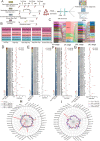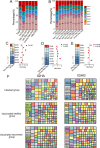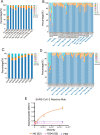Comparative global B cell receptor repertoire difference induced by SARS-CoV-2 infection or vaccination via single-cell V(D)J sequencing
- PMID: 35899581
- PMCID: PMC9377262
- DOI: 10.1080/22221751.2022.2105261
Comparative global B cell receptor repertoire difference induced by SARS-CoV-2 infection or vaccination via single-cell V(D)J sequencing
Abstract
Dynamic changes of the paired heavy and light chain B cell receptor (BCR) repertoire provide an essential insight into understanding the humoral immune response post-SARS-CoV-2 infection and vaccination. However, differences between the endogenous paired BCR repertoire kinetics in SARS-CoV-2 infection and previously recovered/naïve subjects treated with the inactivated vaccine remain largely unknown. We performed single-cell V(D)J sequencing of B cells from six healthy donors with three shots of inactivated SARS-CoV-2 vaccine (BBIBP-CorV), five people who received the BBIBP-CorV vaccine after having recovered from COVID-19, five unvaccinated COVID-19 recovered patients and then integrated with public data of B cells from four SARS-CoV-2-infected subjects. We discovered that BCR variable (V) genes were more prominently used in the SARS-CoV-2 exposed groups (both in the group with active infection and in the group that had recovered) than in the vaccinated groups. The VH gene that expanded the most after SARS-CoV-2 infection was IGHV3-33, while IGHV3-23 in the vaccinated groups. SARS-CoV-2-infected group enhanced more BCR clonal expansion and somatic hypermutation than the vaccinated healthy group. A small proportion of public clonotypes were shared between the SARS-CoV-2 infected, vaccinated healthy, and recovered groups. Moreover, several public antibodies had been identified against SARS-CoV-2 spike protein. We comprehensively characterize the paired heavy and light chain BCR repertoire from SARS-CoV-2 infection to vaccination, providing further guidance for the development of the next-generation precision vaccine.
Keywords: BCR repertoire; COVID-19; SARS-CoV-2 infection; SARS-CoV-2 vaccination; inactivated vaccine; single-cell RNA sequencing.
Conflict of interest statement
No potential conflict of interest was reported by the author(s).
Figures






Similar articles
-
Characterizing the cellular and molecular variabilities of peripheral immune cells in healthy recipients of BBIBP-CorV inactivated SARS-CoV-2 vaccine by single-cell RNA sequencing.Emerg Microbes Infect. 2023 Dec;12(1):e2187245. doi: 10.1080/22221751.2023.2187245. Emerg Microbes Infect. 2023. PMID: 36987861 Free PMC article.
-
Imprints of somatic hypermutation on B-cell receptor immunoglobulins post-infection versus post-vaccination against SARS-CoV-2.Immunohorizons. 2025 May 30;9(7):vlaf021. doi: 10.1093/immhor/vlaf021. Immunohorizons. 2025. PMID: 40489958 Free PMC article.
-
Altered T-cell receptor β repertoire in adults with SARS CoV-2 inactivated vaccine of BBIBP-CorV.Mol Immunol. 2023 Oct;162:54-63. doi: 10.1016/j.molimm.2023.08.005. Epub 2023 Aug 28. Mol Immunol. 2023. PMID: 37647774
-
The characteristics of TCR CDR3 repertoire in COVID-19 patients and SARS-CoV-2 vaccine recipients.Virulence. 2024 Dec;15(1):2421987. doi: 10.1080/21505594.2024.2421987. Epub 2024 Nov 4. Virulence. 2024. PMID: 39468707 Free PMC article. Review.
-
Profiling the B cell immune response elicited by vaccination against the respiratory virus SARS-CoV-2.Front Immunol. 2022 Nov 24;13:1058748. doi: 10.3389/fimmu.2022.1058748. eCollection 2022. Front Immunol. 2022. PMID: 36505416 Free PMC article. Review.
Cited by
-
A synthetic heavy chain variable domain antibody library (VHL) provides highly functional antibodies with favorable developability.Protein Sci. 2025 Apr;34(4):e70090. doi: 10.1002/pro.70090. Protein Sci. 2025. PMID: 40100169
-
A protein vaccine of RBD integrated with immune evasion mutation shows broad protection against SARS-CoV-2.Signal Transduct Target Ther. 2024 Nov 6;9(1):301. doi: 10.1038/s41392-024-02007-8. Signal Transduct Target Ther. 2024. PMID: 39500906 Free PMC article.
-
Reading of human acute immune dynamics in omicron SARS-CoV-2 breakthrough infection.Emerg Microbes Infect. 2025 Dec;14(1):2494705. doi: 10.1080/22221751.2025.2494705. Epub 2025 May 6. Emerg Microbes Infect. 2025. PMID: 40231451 Free PMC article.
-
Characterization of B-cell receptor clonality and immunoglobulin gene usage at multiple time points during active SARS-CoV-2 infection.J Med Virol. 2023 Oct;95(10):e29179. doi: 10.1002/jmv.29179. J Med Virol. 2023. PMID: 37877800 Free PMC article.
-
The 2nd China Vaccinology Integrated Innovation & Teaching Development Conference: Promoting the construction of vaccinology discipline system.Hum Vaccin Immunother. 2024 Dec 31;20(1):2300157. doi: 10.1080/21645515.2023.2300157. Epub 2024 Jan 10. Hum Vaccin Immunother. 2024. PMID: 38198292 Free PMC article.
References
MeSH terms
Substances
LinkOut - more resources
Full Text Sources
Other Literature Sources
Medical
Miscellaneous
